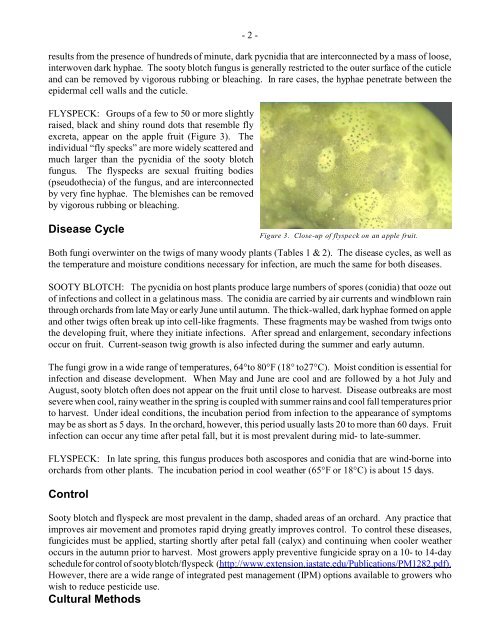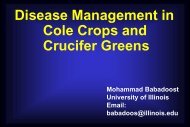Sooty blotch and flyspeck on an apple - Integrated Pest ...
Sooty blotch and flyspeck on an apple - Integrated Pest ...
Sooty blotch and flyspeck on an apple - Integrated Pest ...
Create successful ePaper yourself
Turn your PDF publications into a flip-book with our unique Google optimized e-Paper software.
- 2 -<br />
results from the presence of hundreds of minute, dark pycnidia that are interc<strong>on</strong>nected by a mass of loose,<br />
interwoven dark hyphae. The sooty <str<strong>on</strong>g>blotch</str<strong>on</strong>g> fungus is generally restricted to the outer surface of the cuticle<br />
<str<strong>on</strong>g><strong>an</strong>d</str<strong>on</strong>g> c<strong>an</strong> be removed by vigorous rubbing or bleaching. In rare cases, the hyphae penetrate between the<br />
epidermal cell walls <str<strong>on</strong>g><strong>an</strong>d</str<strong>on</strong>g> the cuticle.<br />
FLYSPECK: Groups of a few to 50 or more slightly<br />
raised, black <str<strong>on</strong>g><strong>an</strong>d</str<strong>on</strong>g> shiny round dots that resemble fly<br />
excreta, appear <strong>on</strong> the <strong>apple</strong> fruit (Figure 3). The<br />
individual “fly specks” are more widely scattered <str<strong>on</strong>g><strong>an</strong>d</str<strong>on</strong>g><br />
much larger th<strong>an</strong> the pycnidia of the sooty <str<strong>on</strong>g>blotch</str<strong>on</strong>g><br />
fungus. The <str<strong>on</strong>g>flyspeck</str<strong>on</strong>g>s are sexual fruiting bodies<br />
(pseudothecia) of the fungus, <str<strong>on</strong>g><strong>an</strong>d</str<strong>on</strong>g> are interc<strong>on</strong>nected<br />
by very fine hyphae. The blemishes c<strong>an</strong> be removed<br />
by vigorous rubbing or bleaching.<br />
Disease Cycle<br />
Figure 3. Close-up of <str<strong>on</strong>g>flyspeck</str<strong>on</strong>g> <strong>on</strong> <strong>an</strong> <strong>apple</strong> fruit.<br />
Both fungi overwinter <strong>on</strong> the twigs of m<strong>an</strong>y woody pl<strong>an</strong>ts (Tables 1 & 2). The disease cycles, as well as<br />
the temperature <str<strong>on</strong>g><strong>an</strong>d</str<strong>on</strong>g> moisture c<strong>on</strong>diti<strong>on</strong>s necessary for infecti<strong>on</strong>, are much the same for both diseases.<br />
SOOTY BLOTCH: The pycnidia <strong>on</strong> host pl<strong>an</strong>ts produce large numbers of spores (c<strong>on</strong>idia) that ooze out<br />
of infecti<strong>on</strong>s <str<strong>on</strong>g><strong>an</strong>d</str<strong>on</strong>g> collect in a gelatinous mass. The c<strong>on</strong>idia are carried by air currents <str<strong>on</strong>g><strong>an</strong>d</str<strong>on</strong>g> windblown rain<br />
through orchards from late May or early June until autumn. The thick-walled, dark hyphae formed <strong>on</strong> <strong>apple</strong><br />
<str<strong>on</strong>g><strong>an</strong>d</str<strong>on</strong>g> other twigs often break up into cell-like fragments. These fragments may be washed from twigs <strong>on</strong>to<br />
the developing fruit, where they initiate infecti<strong>on</strong>s. After spread <str<strong>on</strong>g><strong>an</strong>d</str<strong>on</strong>g> enlargement, sec<strong>on</strong>dary infecti<strong>on</strong>s<br />
occur <strong>on</strong> fruit. Current-seas<strong>on</strong> twig growth is also infected during the summer <str<strong>on</strong>g><strong>an</strong>d</str<strong>on</strong>g> early autumn.<br />
The fungi grow in a wide r<strong>an</strong>ge of temperatures, 64°to 80°F (18° to27°C). Moist c<strong>on</strong>diti<strong>on</strong> is essential for<br />
infecti<strong>on</strong> <str<strong>on</strong>g><strong>an</strong>d</str<strong>on</strong>g> disease development. When May <str<strong>on</strong>g><strong>an</strong>d</str<strong>on</strong>g> June are cool <str<strong>on</strong>g><strong>an</strong>d</str<strong>on</strong>g> are followed by a hot July <str<strong>on</strong>g><strong>an</strong>d</str<strong>on</strong>g><br />
August, sooty <str<strong>on</strong>g>blotch</str<strong>on</strong>g> often does not appear <strong>on</strong> the fruit until close to harvest. Disease outbreaks are most<br />
severe when cool, rainy weather in the spring is coupled with summer rains <str<strong>on</strong>g><strong>an</strong>d</str<strong>on</strong>g> cool fall temperatures prior<br />
to harvest. Under ideal c<strong>on</strong>diti<strong>on</strong>s, the incubati<strong>on</strong> period from infecti<strong>on</strong> to the appear<strong>an</strong>ce of symptoms<br />
may be as short as 5 days. In the orchard, however, this period usually lasts 20 to more th<strong>an</strong> 60 days. Fruit<br />
infecti<strong>on</strong> c<strong>an</strong> occur <strong>an</strong>y time after petal fall, but it is most prevalent during mid- to late-summer.<br />
FLYSPECK: In late spring, this fungus produces both ascospores <str<strong>on</strong>g><strong>an</strong>d</str<strong>on</strong>g> c<strong>on</strong>idia that are wind-borne into<br />
orchards from other pl<strong>an</strong>ts. The incubati<strong>on</strong> period in cool weather (65°F or 18°C) is about 15 days.<br />
C<strong>on</strong>trol<br />
<str<strong>on</strong>g>Sooty</str<strong>on</strong>g> <str<strong>on</strong>g>blotch</str<strong>on</strong>g> <str<strong>on</strong>g><strong>an</strong>d</str<strong>on</strong>g> <str<strong>on</strong>g>flyspeck</str<strong>on</strong>g> are most prevalent in the damp, shaded areas of <strong>an</strong> orchard. Any practice that<br />
improves air movement <str<strong>on</strong>g><strong>an</strong>d</str<strong>on</strong>g> promotes rapid drying greatly improves c<strong>on</strong>trol. To c<strong>on</strong>trol these diseases,<br />
fungicides must be applied, starting shortly after petal fall (calyx) <str<strong>on</strong>g><strong>an</strong>d</str<strong>on</strong>g> c<strong>on</strong>tinuing when cooler weather<br />
occurs in the autumn prior to harvest. Most growers apply preventive fungicide spray <strong>on</strong> a 10- to 14-day<br />
schedule for c<strong>on</strong>trol of sooty <str<strong>on</strong>g>blotch</str<strong>on</strong>g>/<str<strong>on</strong>g>flyspeck</str<strong>on</strong>g> (http://www.extensi<strong>on</strong>.iastate.edu/Publicati<strong>on</strong>s/PM1282.pdf).<br />
However, there are a wide r<strong>an</strong>ge of integrated pest m<strong>an</strong>agement (IPM) opti<strong>on</strong>s available to growers who<br />
wish to reduce pesticide use.<br />
Cultural Methods















